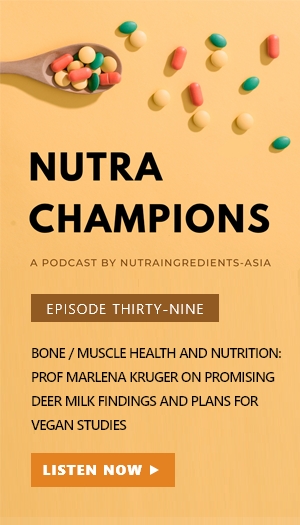‘Mislabelling and contamination’: Almost 70% of protein products tested in India don’t meet label claims

Researchers in India conducted a self-funded analysis on 36 popular protein supplements and found that nearly 70% of them were mislabelled as having more protein than advertised. Other findings include the presence of fungal toxins, pesticides and heavy metals.
“This self-funded transparent report on popular protein brands sold in the Indian market revealed interesting, intriguing, and concerning findings: the majority of protein supplements did not contain labelled and advertised protein content; certain brands contained more than the labelled or advertised protein content, raising concerns of ‘protein/amino-spiking’; fungal toxins and pesticide residues were identifiable even in supposedly ‘good’ brands; heavy metals that negatively impact human health such as lead and arsenic were found within many major formulations; and the presence of broad types of potentially toxic compounds such as industrial solvents and volatile organic compounds within a non-standardised and heterogenous ingredient milieu,” wrote the researchers in Medicine.
Dr Cyriac Abby Phillips, the author of this paper, believes that there is a growing concern over hepatotoxicity, and potential links with liver injury, failure, and death.
Citing similar mislabelling and contamination cases in the United States, Dr Abby drew parallels between the United States Food and Drug Administration (FDA) and the Food Safety and Standards Authority of India (FSSAI), both of which do not require manufacturers to obtain their approval before sale. Instead, they regulate good manufacturing practices.
The implications
He said the current regulatory framework for food, nutritional, herbal, and dietary supplements in India was “broken, apathic and pendulous”. He feels that the FSSAI can put in more effort to identify low quality products and make such findings transparent to the public, while imposing harsher punishments on those who flout food safety regulations.
He attributes the presence of harmful substances in the protein supplements to a lack of good manufacturing practices and poor choice of ingredients.
“For example, whey protein is not toxic to human health. It is a complete protein with best digestibility and high bioavailability. But when whey protein is blended with other ingredients such as botanicals or herbal blends, the chances of contamination increases. This was clearly shown in our study where herbal-blend based protein supplements were more contaminated than pure whey-based nutritional supplements. Contamination can occur from the raw source (due to inadequate processing), the manufacturing machinery (due to common use in preparation of a wide range of products) and from processing materials, transport and storage conditions and environmental sources,” said Dr Abby, who emphasised that the study adhered to all pertinent regulatory standards or guidelines for product testing and is therefore accurate.
However, Sandeep Gupta, founder and CEO of Expert Nutraceutical Advocacy Council (ENAC), said that there should be a more nuanced approach to testing the products.
“In each of these products, the ingredient combination is different. For example, some brands combine protein with herbal ingredients, while others combine protein with multivitamins. The method of analysis should never remain the same for different products unless the combination of ingredients is identical.”
This is because different ingredients interact with each other in various ways. The dynamics of each type of combination may cause either protein spikes or a drop in the level of proteins.
Gupta also emphasised that it is important to have the findings validated by at least three different certified agencies before drawing conclusions.
As for the researchers’ claim that Indian-made products were inferior to those manufactured by multinational companies, Gupta said that none of these companies own manufacturing facilities. In fact, all of them are manufactured by a third party in India, who receives the protein sources from different parts of the world.
“If we want to bring protein into India, why not put the burden of ensuring the quality and safety of this raw material on the supplier? Let them produce certificates, perform tests, or whatever else that needs to be done before they bring it into India,” said Gupta.
Dr Abby, however, feels that the primary responsibility lies with the government regulatory bodies.
“If they are stringent, then the manufacturers, suppliers and trade associations will fall into place. Regular review, safety assessments, quality control and letters of concern must be served to manufacturers and others engaged in sale of nutritional supplements and these letters of concern must be made public. This ensures that the public can trust the government regulation and the product quality assessment becomes transparent.”
On the other hand, Gupta feels that every stakeholder has equal responsibility to ensure the quality and safety of every product.
“This includes the regulator, the food business operator and the supplier. Each party has to self-regulate and adhere to good manufacturing practices.”
At present, the safety of contents in protein-based supplements must be assured by the manufacturer, while the content and labelling are scrutinised by the FSSAI based on test results submitted by the manufacturer, which are not made public.
This prompted Dr Abby to lead a study to analyse popular protein products and provide transparency with regards to content, labelling, adulteration, and contamination.
The study
Over the course of two months, the researchers obtained 36 popular protein-based herbal and dietary supplements from manufacturers and authorised dealers.
All products were tested for protein content, fungal toxins, pesticides, heavy metals (arsenic, cadmium, lead, mercury, thalium, and copper), steroids, and other organic or inorganic elements.
Of 36 products, nine had less than 40% detected protein content, while the rest had above 60%. Overall, 25 protein supplements (69.4%) were mislabelled about protein content; that is, the protein content per 100 g detected in analysis was less than what was advertised on the product, with about 10–50% deficit; five out of 36 (13.9%) samples were found to be contaminated with aflatoxins; three samples (8.3%) were found to be contaminated by trace amounts of pesticides; none of the protein powder contained mercury or thallium. Trace levels of arsenic were detected in five, cadmium in 10 (27.8%), lead in 27 (75%), and copper in 34 (94.4%) samples.
Some of them contained herbal extracts such as green tea, curcumin, ashwagandha and garcinia cambogia, which the researchers labelled as well-documented and inherent hepatotoxic herbal ingredients, meaning it can cause liver damage.
The researchers also pointed out that higher protein content could suggest either good quality protein sources used in manufacturing or it could also be part of “protein or amino spiking”, where supplement manufacturers intentionally add cheaper protein components such as cheaply available amino acids glycine and taurine to deceptively showcase higher protein content.
Towards improving food safety and quality
Gupta stressed that he is neither challenging nor agreeing with Dr Abby’s findings. Rather, he feels it is important for the appropriate institutions to deal with the issues raised by these findings.
“People with the right of power, who set the rules and regulations for the good of the public, and who have the right resources to conduct checks and balances, they should be the ones to monitor the challenges faced by the protein supplements industry.”
For Gupta, the important questions to ask are: Do these agencies have the right infrastructure or equipment to conduct tests and analyses? Are they using the appropriate methods to study the products? Have these methods been validated by the authorities?
“At the end of the day, this report can only enlighten. It can form the basis for further research.”
“It’s all in the interest of public health. We need to be sensible and responsible because our own families and loved ones are out there too and they could be consuming whatever you’re manufacturing. So, treat everyone as your own.”
Gupta said that India has one of the most advanced regulatory systems in the world for monitoring the safety and quality of food products, but the individual stakeholders need to do their part to ensure the wellbeing of consumers.
“FSSAI is the central authority that’s monitoring the rules and regulations. It is supported by regional authorities, which are in turn supported by state authorities. So, there's a proper infrastructure in place for regulating good manufacturing practices. The labs to which protein powders are sent for testing, these were all approved by the FSSAI. These labs are periodically certified from time to time, and random checks will be conducted.”
There are online channels for the public to lodge complaints or concerns, and the FSSAI will order checks on the affected product.
“FSSAI takes such matters very seriously, and any person or business caught flouting the regulations will be heavily penalised,” said Gupta.
Source: Medicine
DOI: 10.1097/MD.0000000000037724
“Citizens protein project: A self-funded, transparent, and concerning report on analysis of popular protein supplements sold in the Indian market”
Authors: Philips, Cyriac Abby; Theruvath, Arif Hussain et al.
Active Lifestyle Nutrition will be a major topic of focus at Growth Asia Summit 2024 – join us in Singapore to learn about market opportunities and glean insights from major industry experts. Find out more here.



















